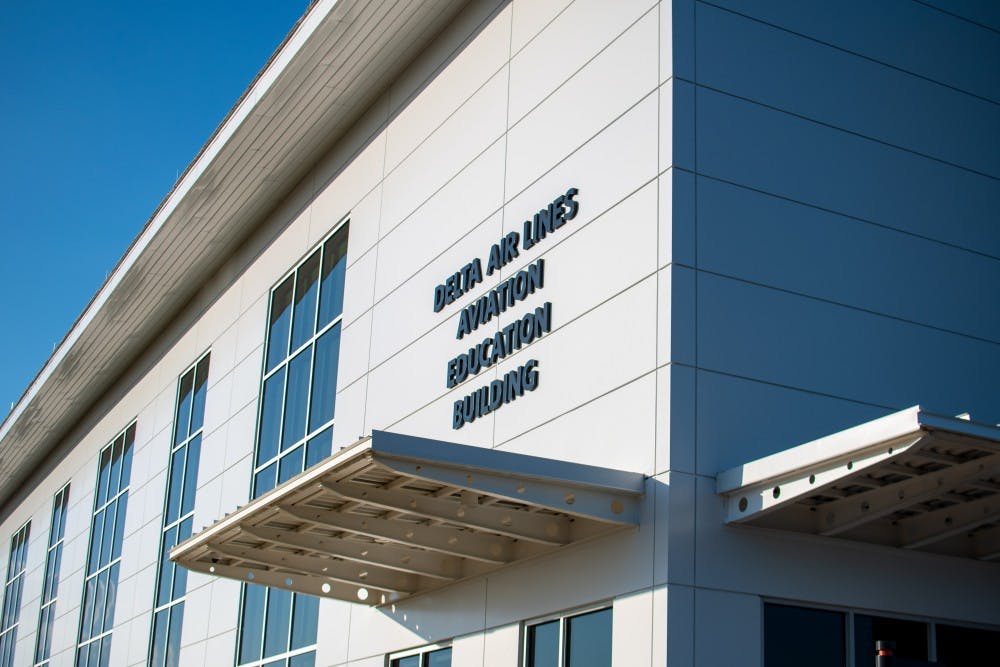The Auburn University Regional Airport has received several major additions to its grounds in accordance to its 2005–19 master plan. Many of the proposed plans have been completed, including a new maintenance hangar, the Delta Airlines Aviation Education Building and the resurfacing of a runway.
Most standard projects are funded 90% by the Federal Aviation Administration, 5% by the state and the remaining 5% is split between the City of Auburn, Lee County and the University, Airport Director Bill Hutto said.
Projects such as the Delta Airlines Aviation Education Building were funded in part through donors, in this case Delta Airlines.
Over the past few years, the airport has seen an increase in traffic, especially on game days, Hutto said. The airport is attempting to acquire funding from the FAA to pave more ramp space for parked planes and helicopters, Hutto said.
Hutto has been the airport’s director since 2001. He previously served as the director of the Titusville-Cocoa Airport Authority. He has also served in organizations such as the Aviation Accreditation Board International, the Aviation Council of Alabama and the Aviation Committee for the Aerospace States Association.
“I would say at least three or four times a month or more, we have a full ramp,” Hutto said. “It is not uncommon for us to see the larger jets that take a lot of room that really drive the capacity down.”
In addition, the airport has seen quite a bit of helicopter and military traffic coming into the area on training runs, which take up a lot of room on the ramp, Hutto said.
The airport does not turn away aircraft when at full capacity. Instead, the airport shuts down the smaller of their two runways and uses it for additional parking space.
Many of the runways and taxiways are in the process of being resurfaced. The smaller of the two runways was resurfaced recently with a budget of $800,000, and the larger runway will be repaved soon, Hutto said.
“It’s asphalt, so after 15 to 20 years, they begin to crack and aggregate begins to form,” Hutto said. “[The larger runway] will probably be resurfaced in the springtime of 2021. We can get the funding before that, but we don’t want to start that project during football season.”
Because of the FAA’s standards for Instrument Landing Systems, the north end of Taxiway A was relocated this summer to maintain the minimum of 400 feet from the runway. The airport is awaiting FAA funds to resurface the south end of the taxiway within the next three-to-five years.
The airport is used as a flight school for Auburn University aviation students. It also funcations like a regular airport for nonscheduled charter or freight services.
The airport built a maintenance hangar in 2017 capable of fixing a variety of aircrafts. It had an initial budget of $1.7 million.
“We service our Auburn University flight training fleet in that hangar,” Hutto said. “We also service some of our based customers, meaning non-University airplanes that are either tied down on the airfield or rent a hangar from us.”
It is roughly 9,600 square feet of workspace with plans to extend the hangar floor to 12,000 sq. ft. There are also plans to add a second door for aircrafts to the hangar.
It would be best for the airport to secure funding for this project within the next year and a half to two years, Hutto said.
The airport also recently built the Delta Airlines Aviation Education Building in 2018 to provide students in the professional flight and aviation management majors the skills required to become pilots. Its initial budget was $8.7 million.
“It is the base of operation for our flight training fleet, where we issue aircraft to our instructors and student pilots,” Hutto said. “We have seven total [simulators]. Six of them are used for our flight training fleet.”
One of those simulators is an Airbus A320 simulator, which Delta Airlines gave the airport as a gift, Hutto said. Operating the simulator will be the capstone course for the professional flight degree, Hutto said.
“The course] will be a bridge from the piston engine training aircraft we fly to what [students] will see in the airlines,” Hutto said.
The Airbus A320 simulator will be getting an upgraded visual system, which will allow for more realism during training. The system will be installed in December and the old system will be donated to the Department of Aerospace Engineering.
The airport still has other projects planned, such as new hangars, which will be rented out for plane storage. There are also plans for a parallel taxiway for the east-west runway, which does not currently have one. Both are included in the three-to-five-year plan for the airport.
“We are truly blessed that we have the support of the University that sees a need for a strong airport and aviation program,” Hutto said. “We’re able to do what we do because of partnerships with local governments and Auburn University working together to improve aviation for our area.”
Do you like this story? The Plainsman doesn't accept money from tuition or student fees, and we don't charge a subscription fee. But you can donate to support The Plainsman.





